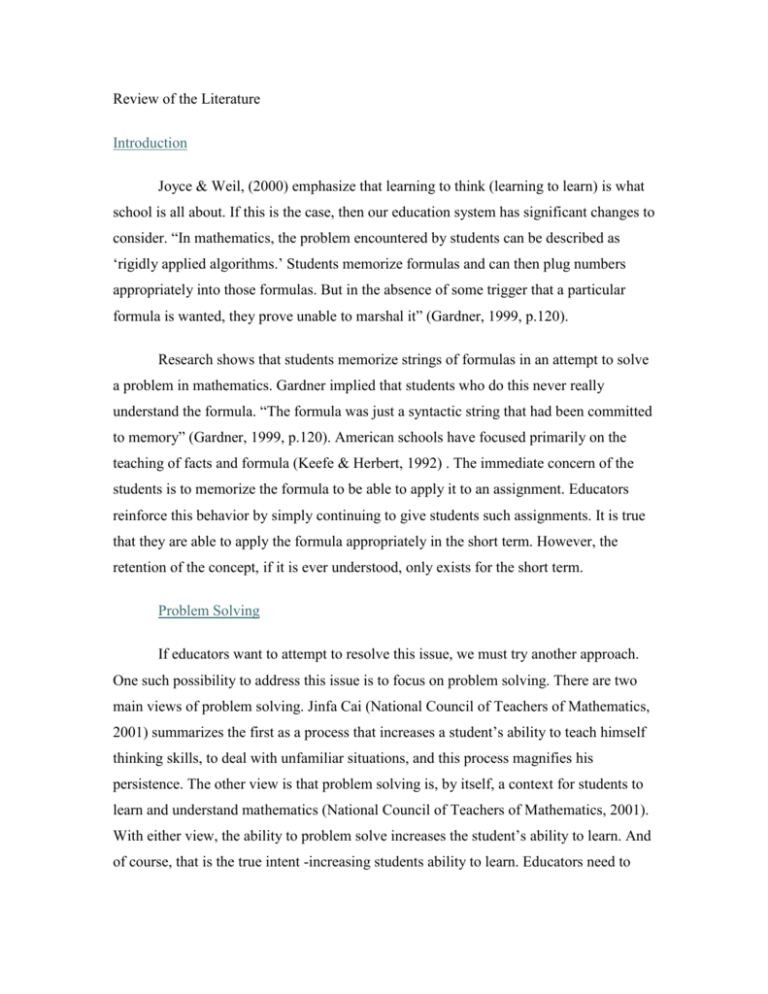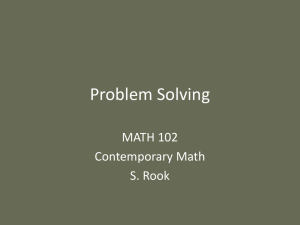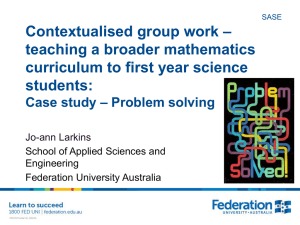Example 1
advertisement

Review of the Literature Introduction Joyce & Weil, (2000) emphasize that learning to think (learning to learn) is what school is all about. If this is the case, then our education system has significant changes to consider. “In mathematics, the problem encountered by students can be described as ‘rigidly applied algorithms.’ Students memorize formulas and can then plug numbers appropriately into those formulas. But in the absence of some trigger that a particular formula is wanted, they prove unable to marshal it” (Gardner, 1999, p.120). Research shows that students memorize strings of formulas in an attempt to solve a problem in mathematics. Gardner implied that students who do this never really understand the formula. “The formula was just a syntactic string that had been committed to memory” (Gardner, 1999, p.120). American schools have focused primarily on the teaching of facts and formula (Keefe & Herbert, 1992) . The immediate concern of the students is to memorize the formula to be able to apply it to an assignment. Educators reinforce this behavior by simply continuing to give students such assignments. It is true that they are able to apply the formula appropriately in the short term. However, the retention of the concept, if it is ever understood, only exists for the short term. Problem Solving If educators want to attempt to resolve this issue, we must try another approach. One such possibility to address this issue is to focus on problem solving. There are two main views of problem solving. Jinfa Cai (National Council of Teachers of Mathematics, 2001) summarizes the first as a process that increases a student’s ability to teach himself thinking skills, to deal with unfamiliar situations, and this process magnifies his persistence. The other view is that problem solving is, by itself, a context for students to learn and understand mathematics (National Council of Teachers of Mathematics, 2001). With either view, the ability to problem solve increases the student’s ability to learn. And of course, that is the true intent -increasing students ability to learn. Educators need to help students make the necessary mathematical connections. Problem solving is one such way of accomplishing this objective (Polya, 1957). “But I shall take pains to state in clear words the rules and ways of investigation which are followed by all able men, who in most cases are not even conscious of following them” (Bolzano cited in Polya, 1957, p.57). Some students acquire the ability to problem solve, while others that have had the same experiences do not acquire these skills. The student should be able to work with a set of predefined steps to solve a problem whether they work at a conscious or unconscious level. Paul A. Forester, the author of both Algebra I: Expressions, Equations, and Applications and Algebra and Trigonometry: Functions and Applications which have been adopted at several California high schools, breaks down the problem into these steps. However, Forester does not make the students aware of these steps. Instructors, authors, and mentors, should not break the problem down, but rather give the students tools: an independent blue print from the problem, general steps or questions to solve problems. “Moreover, when the teacher solves a problem before the class, he should dramatize his ideas a little and he should put to himself the same questions which he uses when helping the students” (Polya, 1957, p.5). Without this, the student does not acquire the skills to problem solve; rather the student goes through the instructor’s, the author’s, or the mentor’s problem solving skills, not their own. Consequently, the student does not develop these skills--he does the work through someone else’s problem solving skills (Polya, 1957). Research has shown that the active involvement of progressing through each of the individual steps is crucial (Wheatley, 1991). The learner must find himself engaged in activities that help them handle the new knowledge in an efficient manner. Once engaged, knowledge is no longer passively received, but is built by the learner (Wheatley, 1991). An example of this set of steps would be to define the variables, write the equation, and apply the equation to a couple of circumstances (Polya, 1957). Using the ideas of Polya and others, instructors can lead students into their investigation by asking questions such as, “How do you answer each of the individual parts, rather than attempting to solve the whole problem at once?” By giving the student a problem and an independent set of steps to solve problems in general, the student has to ask himself, “Where am I in the process?” and “What am I going to ask myself to get to the next step?” The teacher cannot control the act of learning, but rather he can increase the probability of specific behaviors through the promotion and support of various activities (Gagnè, 1985). If the teacher tends to ask guiding questions that lead their students through the teacher’s instruction, even the student that is an active participant in the lecture and in the review of challenging problems from the homework isn’t necessarily gaining any problem solving ability from the instruction. The student gains little or none of these skills, because the student has not internalized a set of problem solving steps. The timeappropriate questions demonstrate the teacher or author’s problem-solving ability. Again, the questions do not represent the student’s ability to problem solve. The presentation of the problem solving process is often too subtle for the student to pick up on in a lecture format. The student needs to have significant opportunities to acquire problem-solving skills, while the instructor helps the students discreetly (Polya, 1957). Scaffolding through the acquisition of the skills of problem solving is key. “In other words, the heuristics should be taught as concepts, and named, with the objective that, for example, the term ‘making a plan’ evokes in the students mind a range of well defined plans which he has used for different problems” (Bell, Costello, & Kuchemann, 1983, p.209). A student’s ability to ask himself and others the time-appropriate questions of the problem solving process assists in the success of the problem (Polya, 1957). Examples of such questions are as follows: What is the problem and do I understand it? What am I trying to solve? What does that mean? Have I seen a problem similar to this that I have solved before? If a student’s time is filled with repetitious exercises and routine operations, his intellectual development is squandered. As indicated above, if educators can help students to solve their questions with questions, then we stimulate their interest in a means of independent thinking (Polya, 1957). Cooperative Projects Using cooperative grouping is an option to assist students in the ability to problem solve (Davidson, 1990). Members of a cooperative group have the ability to learn from the teacher as well as from one another. The learners have a collective unit that generates discussion rather than isolation. “Also, shared responsibility and interaction produce more positive feelings towards the tasks and others, generate better inter-group relations, and result in better self images…”(Joyce & Weil, 2000, p.34). Ultimately, the collective group is greater than the sum of its members. The teacher, who organizes activities so that students work in pairs or large groups, share responsibility, and help one another, increases the mastery of material by all individuals within the class. Talking through math problems with classmates, the student understands how to solve problems correctly (Davidson, 1990). In such cases, the student demonstrates and explains his reasoning to others with mathematical terminology. Davidson (1990) highlights the five components to cooperative groups: 1. The teacher clearly structures positive interdependence within each group. 2. The student engages in face-to-face interaction during the assignment. 3. The teacher structures the activity to ensure individual accountability and the learning of all in the group. 4. The student utilizes interpersonal and group skills. 5. The teacher creates opportunities for groups to evaluate their collective effectiveness (Davidson, 1990, p. 105-106). The teacher taking an active role in the above components increases the likelihood of success for any group within the class. The teacher’s role is to facilitate groups, intervene as needed to direct groups in the appropriate educational goals, and supervise the group’s activities. The student will need the ability to problem solve in their future, both in the workplace and at home (Thornburg, 2000). He will need to be able to communicate, collaborate, and critically think to be successful. Besides being promoted through cooperative groups, these abilities are inherent in project-based learning. Thornburg (2000) contended that in such a learning activity, the student engages his mind fully in the educational process, not only gaining mastery of the information he needs, but exercising his creativity in ways that keep open the doors for lifelong learning. Thus, the student immersed in cooperative, project-based learning will benefit from the ability to transfer these skills from the classroom to the workplace. The most intelligent individuals in the world who are unable to express their ideas clearly to others and lack the social skills needed to work in collaborative teams are unemployable (Thornburg, 2000). Cooperative project-based learning needs to become an integral component of instruction, not just an opportunity for the student to be involved in a supplemental activity. Rather than just having the student solve two-step equations or evaluating expressions, the student should be afforded the opportunity to develop cooperative and team-oriented behavior as this will benefit him in his ability to be a life-long learner and to solve challenging problems. In cooperative groups and project-based learning the student does this; the student connects relevant concepts to one another through interaction and shared responsibility as the project is completed. The student learns to appreciate the ability of others within the group; he is willing to give assistance to other group members, as well as being willing to ask for assistance from other group members (Riel & Fulton, 2001). The student utilizes the ability to problem solve in order to produce a meaningful product and he will need this ability in his future. November (2001) has stated that communication, collaboration, and critical thinking are among six skills needed to solve real problems. Having a deep understanding of a concept enables the student to internalize and used the concept to problem solve. Web-Based Technology “Imagine the possibility of our students providing a web page that is a genuine service to the Internet community, something the students care about, and something that is needed” (Ryder, 1996). The implication from Ryder’s comment is that technology can easily be a tool to assist in the project-based learning. The student can use a computer first as a tool that improves his productivity. Technology and media extend the student’s capabilities to see, hear, and learn (Ryder, 1996). As the student becomes less conscious of the use of technology, he uses it as an extension of his own intentioned will (Ryder, 1996). As an individual becomes more efficient, he has the freedom to focus on less mundane activities and more time to reflect on higher order thinking (November, 2001). The more reflective students are, the more likely they are to improve their products. Teaching the student about computer applications for productivity purposes is not the ultimate goal. “Educational technology is about educating students, serving our communities, and improving our institutions and society” (Burniske, 2001,p. 527). The teacher does not teach computer technology for the sake of learning about computers, but he teaches computer technology to increase student achievement. Burniske has indicated that computer technology integration in content areas should be a consequence of the learning goals for our students. Meaningful learning can results from the desire to interact with the Web environment. “The force toward meaningful learning will be curiosity, puzzlement, and a desire to understand fuzzy aspects of the social and intellectual world encountered on the Internet and the World Wide Web” (Geisert & Futrell, 2000, p. 96). Students are more likely to persist in attaining and utilizing technology if the technology encompasses meaningful learning to the students. Distance learning is equally or more effective than traditional instruction when the implementation of methods and technologies is appropriately used to the educational activity, when either there is student-to-student interaction or there is timely teacher-to-student feedback (Barron, 1999). The Internet and the World Wide Web collaborative conferencing capabilities (a discussion board, for example) enhance instructor-student and student-to-student interaction (Rafaeli & Ravin, 1997). Hence, these collaboration tools complement student learning (Dwyer, Barbieri, & Doerr, 1995). In order to integrate technology into the classroom, cooperative, project-based learning offers significant opportunities for teachers to acquire technological skills. “Teachers need an ability to manage the use of many technologies in the classroom without having to know the technical details” (November, 2001, p. 39). In other words, teachers do not have to pretend that they have knowledge and understanding of everything. Students respect teachers more when the teacher looks for assistance to solve technical problems. November (2001) stated, in reference to technology, “Do not worry about learning the skills. It is more important to learn what the students can do with the skill that might add value to their class work” (p. 39). If the instructor has a general idea what the application can do for him, then the students will problem solve and use their fellow students to direct their way through to a solution. The teacher should be willing to ask a student questions similar to: How did you accomplish creating that object? What were the keystrokes in making the two lines perpendicular to one another? Again, technology is a means for assisting learning. Educators should not be hesitant to partake in integrating such technologies. The desire to understand aspects of the social and intellectual world encountered on the Internet and the World Wide Web promote learning (Geisert & Futrell, 2000). Summary “Cooperative learning implies a group of students working toward a common learning goal or accomplishment of an allocated task. This is a realistic emulation of the working world, where business goals commonly are reached through a number of people working together.”(Geisert & Futrell, 2000, p. 244) Collaboration, problem solving and technology are all important tools for the future of education. Training in these areas need to become a priority, but not as a teacher assignment only, but to have some relevance to the student. “…it is important for students to share in identifying the problem. Students must have a sense of owning the problem rather than seeing it as an assignment from the teacher.”(November, 2001, p. 50) The job before us now is how to facilitate these different skills. New technologies are opening up ways to approach the problems found in education. New ways to enhance the learning experience and allow students to collaborate with others that are geographically separated are now readily available. The purpose of our research is to evaluate one of those ways.




